South32 has undertaken a review of the carrying value of the Hermosa Project consisting of the Taylor Zn-Pb-Ag deposit and the Clark Mn deposit. South 32 acquired the Hermosa Project through the all-cash offer for TSX listed Arizona Mining Inc. in August 2018, paying C$6.20 per share. This was a 50% premium to market which implied a total equity value of Arizona Mining of C$2.1 billion.
As a result of the review of carrying value, South32’s FY23 financial statements will include a non-cash impairment expense of US$1.3 billion in relation to the Taylor deposit. Following this impairment expense, the carrying value of the Hermosa project will be US$1 billion, with US$482M for the Taylor deposit. The carrying value of the Clark deposit and regional exploration land package is unchanged at US$519M.
The Arizona Mining, 2018 PEA, estimated CAPEX of US$1.2 billion, a post-tax NPV(7) of US$2 billion and an IRR of 48%.
Since concluding the acquisition in 2018, South32 have posted US$900 million in accruals to the Hermosa Project, which would appear singularly excessive for a discrete project which has yet to complete a Feasibility Study or report ore reserves. The very significant delay in progressing the project since 2018, has negatively impacted project economics and shareholder value.
Location
The Property is located approximately 50 miles (81 km) southeast of Tucson, Arizona; 15 miles (24 km) northeast of Nogales in Santa Cruz County, Arizona, and eight miles (13 km) north of the international border with Mexico.
Geology and Mineralization
The Taylor deposit is predominantly hosted in Permian carbonates of the Pennsylvanian Naco Group of southeastern Arizona. It is a CRD (Carbonate Replacement Deposit) style Zn-Pb-Ag massive sulphide deposit. The deposit comprises upper Taylor Sulphide and lower Taylor Deeps domains that have a general northerly dip of 30° and are separated by a low angle thrust fault. Mineralisation within the stacked profile of the thrusted host stratigraphy extends 1,200m from near-surface and is open at depth. Mineralisation is modelled for multiple litho-structural domains for an approximate strike of 2,500m and width of 1,900m.
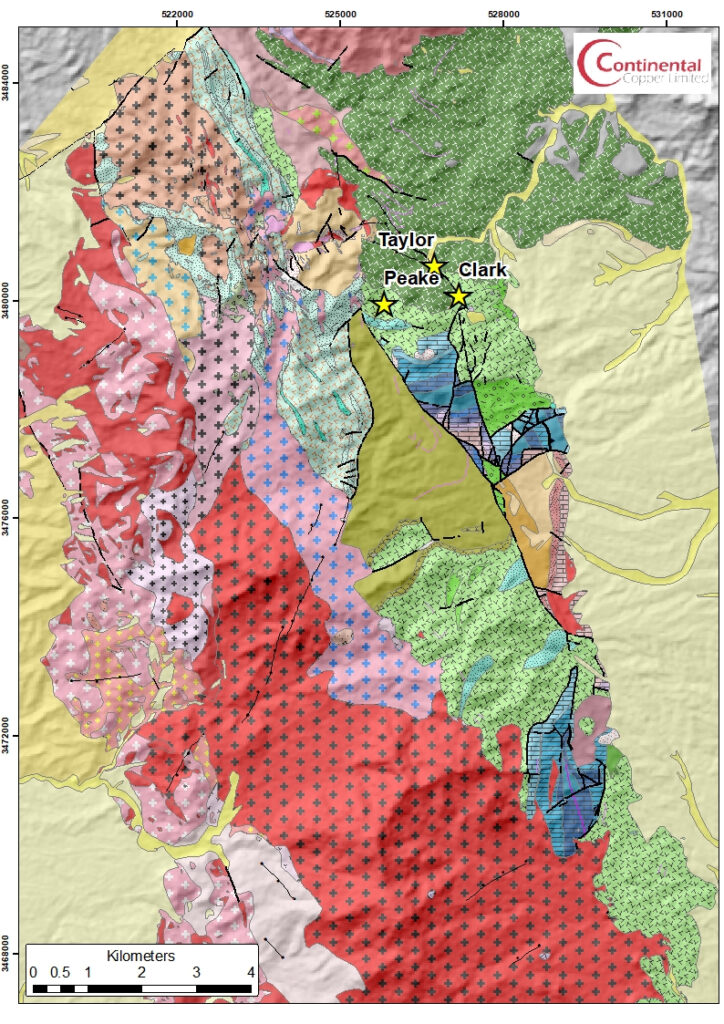
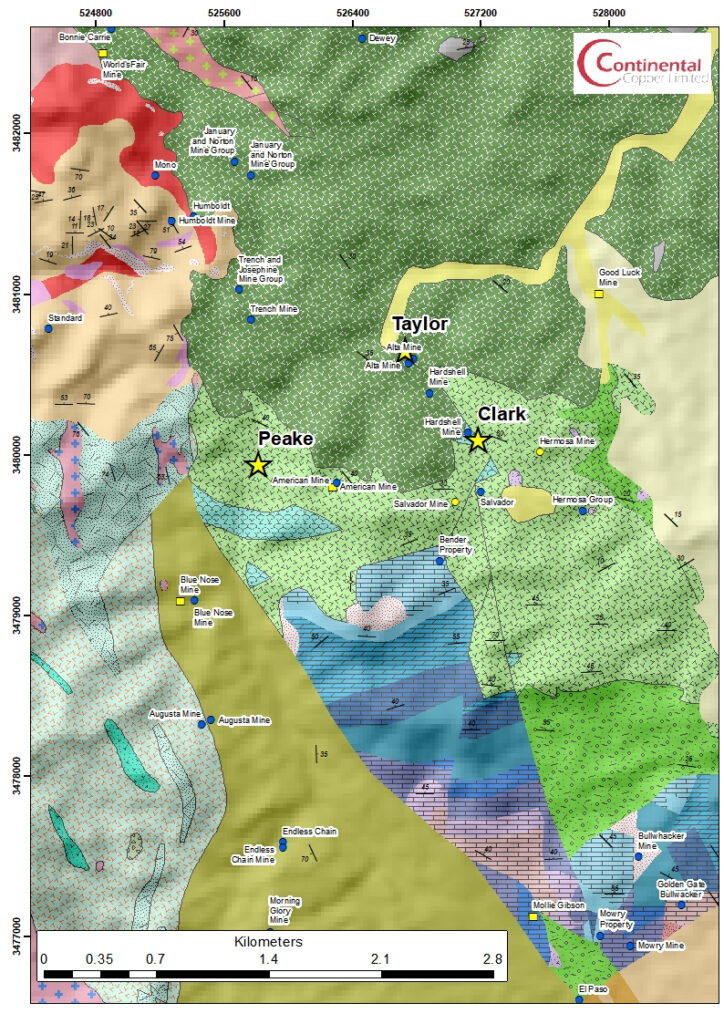
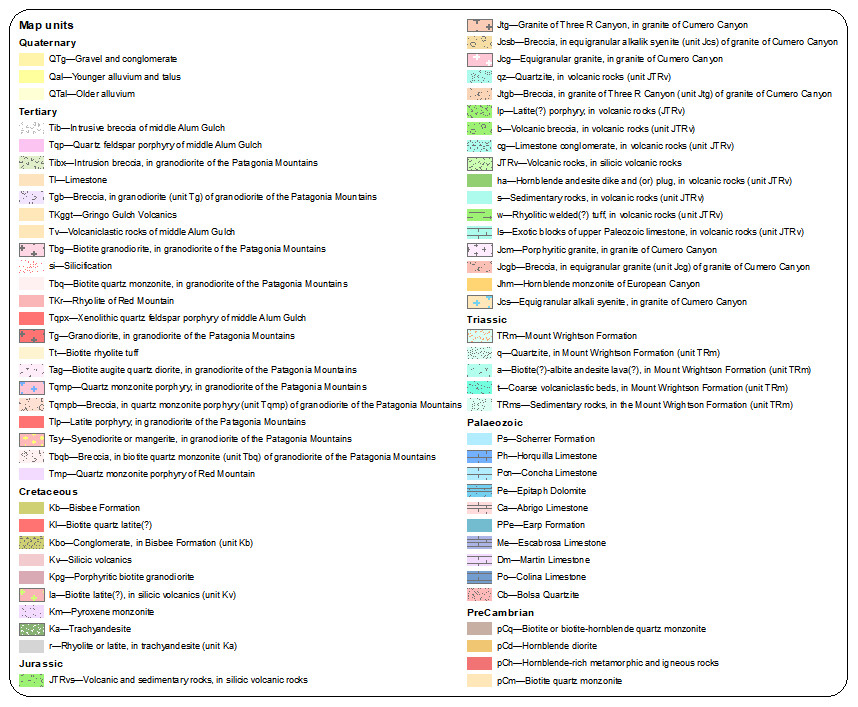
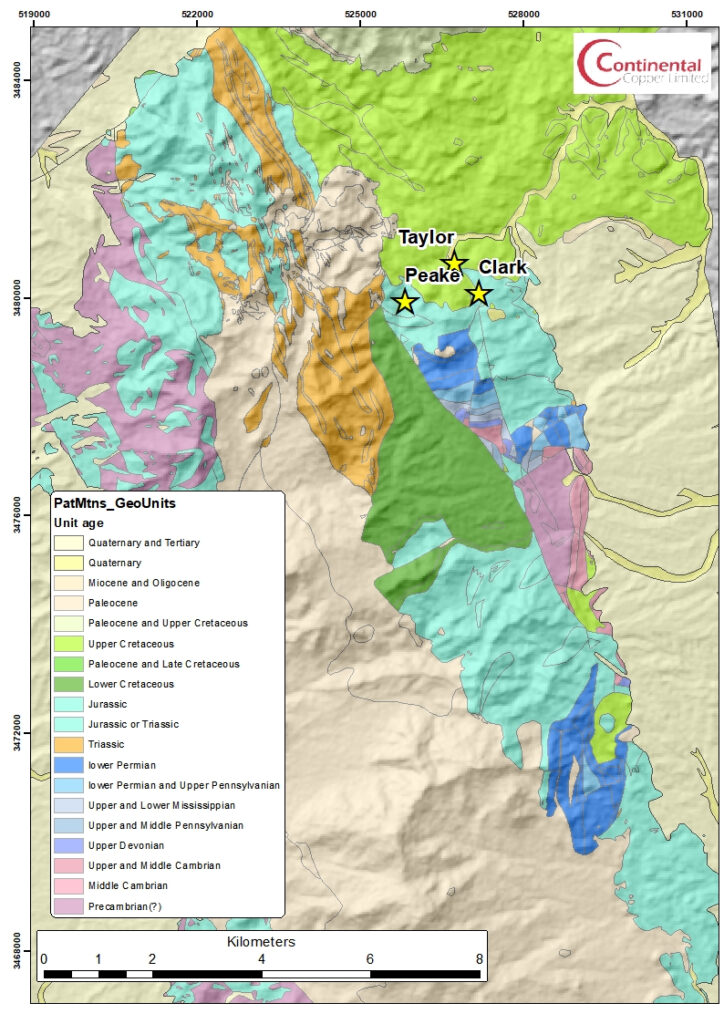
Southeastern Arizona lies within a belt of 1600 to 1700 Ma-age Proterozoic rocks. Late Precambrian-Early Paleozoic rifting split the Proterozoic basement into a number of separate continental blocks with passive continental margins. Phanerozoic shelf-type sediments overlie the Precambrian basement.
The oldest rocks in the Patagonia Mountains are Proterozoic-age granodiorite that are overlain by Cambrian-age sedimentary rocks. Most of Arizona was above sea level during the Ordovician and Silurian. Widespread sedimentary deposition resumed in the upper Devonian. Pennsylvanian-Permian-age sandstones, shales and carbonates were deposited during a time of shifting and cyclical environments. The Pennsylvanian Naco Group of southeastern Arizona is comprised of Pennsylvanian Horquilla Limestone, the Pennsylvanian-Permian Earp Formation and the Permian Colina Limestone, Epitaph Dolomite, Scherrer Formation, and Concha Limestone. The Epitaph Formation, Scherrer Formation, and the Concha Limestone underlie the Hermosa project and are disconformably overlain by Jurassic rhyolites.
Mesozoic-age volcanic, sedimentary and intrusive rocks lie disconformably above the Paleozoic stratigraphic sequence. Cretaceous-age intermediate and felsic volcanic and intrusive rocks cover much of the Property and surrounding areas. In the northwestern Patagonia Mountains, Jurassic granite intrudes Triassic to Jurassic volcanic and sedimentary rocks. Most of the central and southern parts of the range consist of Laramide-age (64 to 58 Ma), medium to coarse-grained hornblende granodiorite batholithic rocks. The batholith is bounded by northwest-striking faults and its emplacement is thought to have been structurally controlled.
Nine stratigraphic domains have been recognized within the Property: three carbonate units of Paleozoic age (in ascending order, Epitaph, Scherrer, and Concha) that are overlain by two volcanic units; the Hardshell (Jurassic age) and Meadow Valley (Cretaceous age) that dip gently to the northwest. A listric thrust that dips to the southwest and predates the two younger volcanic units places the Epitaph, Scherrer and Concha over an older volcanic unit (Older Volcanics Triassic / Jurassic age) and a repeated section of Paleozoic carbonates (Concha, Scherrer, and Epitaph) which were modeled separately and comprise the sixth, seventh, eighth and ninth domains respectively.
The Property hosts two stratigraphically controlled mineral deposits, the Taylor Deposit and the Clark (previously named the Central) Deposit.
- The Taylor Deposit is predominantly a carbonate replacement deposit (CRD) which permeates downward, to significant depth of 3,600 ft (1,100 m), into three recognized sedimentary formations on the Property and is comprised of Zn-Pb-Ag-Cu sulphides
- The Clark Deposit is a Manto-style replacement deposit which is confined to the upper 100 to 500 ft of the Concha limestone and the overlying Jurassic rhyolites. The Clark Deposit is comprised of Mn oxides with accessory silver and zinc carbonate and silicate minerals.

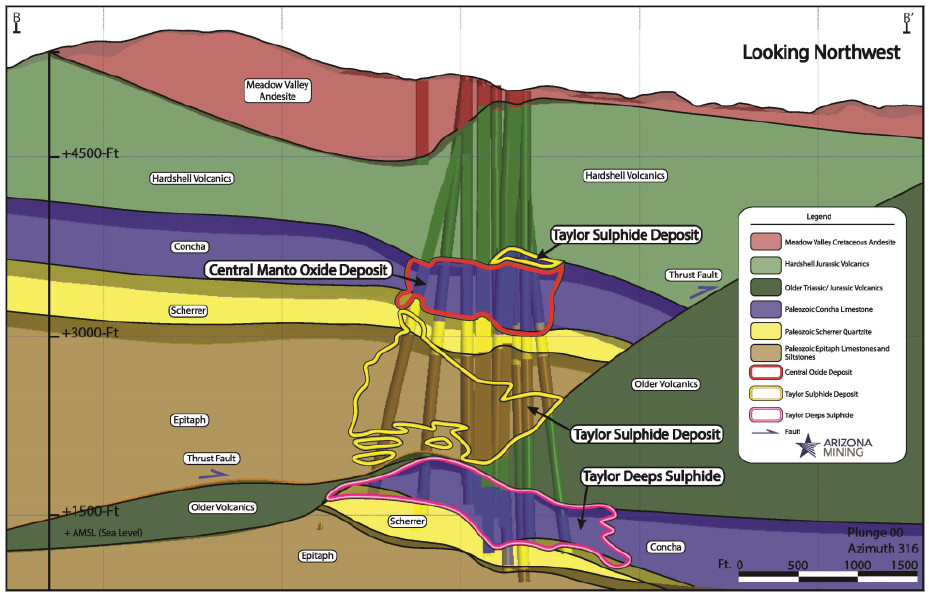
Alteration
The Hermosa property has strong widespread pervasive to moderate K-feldspar alteration evident as a tan to grey coloration. Other alteration includes white kaolinite-sericite, which commonly selectively overprints clasts within the lithic tuff and breccia of the Hardshell volcanic sequence as veinlets and patches. Similarly, the fine-grained, tuffaceous, matrix to the lithic tuff, polymict breccia and lower rhyolite tuff are pervasively overprinted by very-fine, disseminated kaolinite-sericite. In both instances, primary textures are generally well preserved, and the rock remains hard and competent.
The stratabound manto mineralisation is hosted within an asymmetric alteration envelope of pervasive and strong silicification, previously referred to as ‘jasperoid’. The best developed and most massive silicification is within rhyolite tuff in the immediate hanging wall of the mineralisation, commonly persisting for >10 m above the mineralisation. The primary minerals and textures in these volcanic rocks are completely replaced by grey, fine-grained quartz. Although rare, small patches or pods of vague relict volcanic texture have been noted in the hanging wall alteration zone. Where quartz-sulphide veins occur in the Jurassic volcanics, pervasive silicification of the host rock is seen to be associated with that vein-forming event also.
In the immediate footwall carbonate rocks, silicification is less complete and only penetrates a few metres below the volcanic-carbonate contact into the Concha limestone. The carbonate rocks of the Concha, Scherrer and Epitaph formations are weakly to moderately recrystallised and commonly bleached to a light grey colour.
In the northwestern part of the Hermosa property, increasingly pervasive and stronger recrystallisation of the carbonate rocks occurs, ultimately grading into diopside-wollastonite-rhodonite calc-silicate skarn with associated base metal sulphide mineralisation, as described below. Calcareous sandstone intervals contain fewer calcite veinlets, whilst quartzite only rarely host such veinlets.
Mineralization
After Porter Geoscience: Hermosa-Taylor-Clark
The Hermosa deposits comprise three main styles of mineralisation, namely:
- Rrimary, concordant, carbonate replacement and skarn altered ‘manto’ in Permian sedimentary rocks, which includes the Taylor Sulphide and Taylor Deeps;
- Oxide facies (Clark deposit) lateral to and overprinting primary sulphide mantos of the previous variety;
- Both vein and manto mineralisation within the overlying Mesozoic volcanic sequences.
The Taylor Sulphide deposit occurs in the upper mineralised domain above the ‘Lower Thrust’, hosted by sections of the Permian Concha, Scherrer and Epitaph formations. Mineralisation is continuous for ~1350 m along strike, trending NW at ~310° with a width of ~455 m laterally beneath the eastern edge of the Hardshell claim, extending across the entire Alta claim to the southeastern edge of the Trench claim block. Mineralisation thickness varies with the host unit, with ~60 m in the Concha, ~18 m in the Scherrer and ~90 m in the Epitaph formations.
The Taylor Deeps lies below the ‘Lower Thrust’, and is characterised by a calc-silicate mineralogy. It is hosted within the Permian Concha Formation carbonate sedimentary rocks, below the thrusted base of the Older Volcanics, at a depth of ~1035 m below surface. It averages ~23 m in thickness, with a strike length of 2100 m at a trend of ~310° to the NW, and a width of up to 790 m.
Sulphide mineralisation at the Taylor deposits includes zones of massive replacement of carbonate by galena, sphalerite, chalcopyrite and pyrite up to 6 m, and occasionally to as much as 30 m thick, with associated calc-silicate alteration. This alteration becomes more skarn rich, particularly in the northwestern part of the Hermosa property. The calc-silicate-skarn alteration occurs as patches and more extensive hard, massive, wholesale replacement of carbonate by generally white to pink, very fine-grained to aphanitic, wollastonite-diopside and rhodonite. Significant sections of this skarn contain sparse coarse-grained, radiating crystal aggregates up to 2 cm across, commonly accompanied by coarse-grained, euhedral to subhedral galena, sphalerite, chalcopyrite and pyrite. Light green, massive, coarse-grained garnet with abundant sulphides as disseminations, pods, masses and interstitial replacements are sparsely distributed, deep within the Epitaph Formation in the Taylor Sulphide deposit, where they are directly related to intrusive dykes and sills.
The Clark (or Central) deposit is developed as an overprint to the Taylor Sulphide mineralisation within the Permian Concha Formation, but also extends into the overlying rhyolites of the Jurassic Hardshell Volcanic Sequence in the immediate hanging wall. It is composed of oxide manganese, zinc and silver mineralisation. The oxidised rhyolites overlying the carbonate units contain irregular patches and zones of veinlet-controlled hematite-limonite and sooty Mn-oxide with accessory zinc and silver mineralisation. Manto-style mineralisation in rocks of rhyolitic composition is dominated by black, sooty cryptomelane, with or without yellowish-orange secondary lead-oxides, and with a quartz-dominant gangue mineralogy. Oxide manto-style mineralisation in the carbonate rocks below does not typically contain lead-oxides. Strong, pervasive grey, silicification is also developed and calcite occurs as veinlets, vugs and fracture fill. Drill core intersections containing rhodochrosite and pink calcite are common, whilst rarer sections of hard pinkish rhodonite-bustamite are also observed.
Broadly stratabound volcanic hosted lenses of both sulphide and oxide mineralisation also occur throughout the Hardshell Volcanic Sequence, and are known collectively as the ‘Hardshell Zone’. They are intersected in drill holes from surface testing the underlying carbonate hosted manto mineralisation and appear to be stacked above that zone, although this may be an artefact of the drilling pattern. This zone was the basis of historic production from the Hardshell Incline mine. The principal mineralised horizon in this zone is ore is composed of a 3 to 30 m thick ‘Rhyolite Polymict Breccia’, a minor proportion which was composed of often large (to 3 m diameter) sedimentary carbonate clasts. This unit has been subjected to partial to massive Mn-oxide replacement in the southeast, and partial to massive Pb-Zn sulphide replacement mineralisation in the northwest beneath the Alta and Trench claims. The sulphides principally replace sedimentary carbonate clasts within the breccia.
Mineral Resource Estimate
